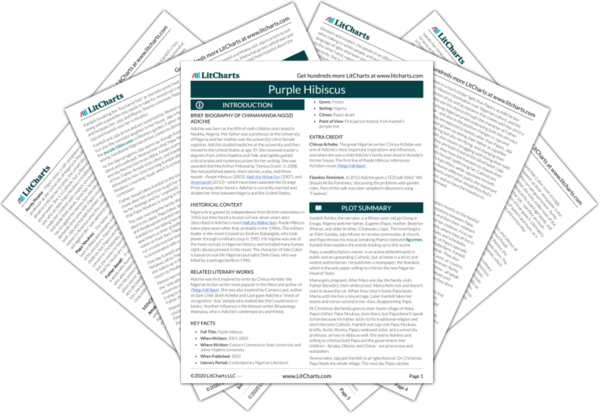Mama has some beloved ceramic figurines of ballet dancers that she keeps on the étagerè. She always polishes them meticulously after Papa beats her. Mama, Kambili, and Jaja never speak aloud of Papa’s violence, but polishing the figurines become a kind of euphemism for his domestic abuse. On Palm Sunday, the turning point for the family, Papa gets angry at Jaja’s open disobedience and throws his missal, breaking the figurines. As she cleans them up, Mama tells Kambili that she won’t need to replace them. This shows that something has changed in the family dynamic, and Mama won’t stand for violence anymore, just as Jaja asserts his independence by disobeying Papa. Thus the figurines symbolize the submissiveness and silence the family lives with under the fear of Papa’s violence, and when the figurines are broken it means the beginning of freedom and free speech.
Get the entire Purple Hibiscus LitChart as a printable PDF.

Mama’s Figurines Symbol Timeline in Purple Hibiscus
The timeline below shows where the symbol Mama’s Figurines appears in Purple Hibiscus. The colored dots and icons indicate which themes are associated with that appearance.
Chapter 1
...a devout Catholic, threw his missal (a Catholic liturgical book) in anger, breaking the ceramic figurines on the étagère (a piece of furniture with a series of shelves).
(full context)
Papa then flings his missal at the étagère and breaks the small ceramic figurines of ballet dancers. Kambili’s mother, Beatrice (Mama), comes in and immediately starts picking up the...
(full context)
Jaja helps Mama pick up the pieces of the figurines, and Kambili feels like she is in a nightmare because everything is so different from...
(full context)
...go upstairs to his room to read. Kambili tells Mama that she is sorry her figurines broke, but Mama just nods and shakes her head as if the figurines weren’t important...
(full context)
...that he didn’t come down for dinner either. Kambili asks if Mama will replace the figurines, and Mama says that she won’t. Kambili starts to understand that everything has changed now,...
(full context)
Chapter 3
...miscarriage. She stands there hugging herself for a while, and then starts polishing the ceramic figurines on the étagère. Kambili tries to help her, but Mama insists that she go up...
(full context)
Chapter 10
...he usually chooses Mama’s favorite shade of beige. Kambili comments that Mama has polished the figurines on the étagère. Mama says that she did it yesterday, and Kambili looks closer at...
(full context)
Chapter 13
...Sunday, when Jaja refuses to go to communion and Papa throws his missal, breaking Mama’s figurines.
(full context)
Chapter 14
...to lower her voice when she tells Sisi to sweep up the rest of the figurines. Mama doesn’t sneak extra food to Jaja’s room as usual, but brings it on a...
(full context)
Chapter 16
...sit in the living room, staring at the spot where the étagère and the ballet-dancer figurines used to be. Mama is upstairs, packing up Papa’s things. She had told the gate...
(full context)












